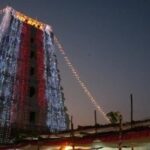Maharashtrian Wada Culture
Maharashtra, a land rich in history and cultural heritage, is known for its majestic forts, vibrant traditions, and age-old architectural marvels. Among these, the concept of ‘Wada’ stands as a significant symbol of the state’s socio-cultural and architectural legacy. The Wada culture, which flourished primarily during the Maratha and Peshwa eras, continues to hold historical and aesthetic value today.
What is a Wada?
A Wada is a traditional mansion or courtyard house that served as the primary dwelling for the noble and elite families of Maharashtra. These grand structures were influenced by both indigenous and Mughal architectural styles, reflecting a blend of functionality, aesthetics, and social hierarchy.
Architectural Significance
A typical Wada is characterized by its massive wooden doors, intricately carved pillars, and expansive courtyards. The layout usually consists of multiple sections:
- The Mahadwara (Main Entrance) – A large, artistically carved wooden door that serves as the entry point.
- The Chowk (Central Courtyard) – The heart of the Wada, where social gatherings, religious rituals, and discussions took place.
- The Devghar (Temple) – A dedicated space for worship, highlighting the deeply rooted spirituality of the inhabitants.
- The Diwankhana (Hall) – Used for official meetings and guest receptions.
- The Kholi (Private Rooms) – Residential quarters designed to offer privacy and comfort to family members.
The construction materials mainly included teak wood, stone, and bricks, ensuring durability and protection from the elements. Many Wadas also featured secret passages and strong fortifications as a defense mechanism during times of conflict.
Cultural and Social Relevance
Wadas were more than just residential spaces; they were the epicenter of social and political activities. Many prominent leaders, including the Peshwas, conducted administrative affairs from these grand mansions. Festivals like Ganesh Chaturthi and Diwali were celebrated with grandeur, bringing together families and communities within these large, interconnected spaces.
In addition to being family homes, Wadas also functioned as centers of learning, with scholars and poets engaging in discussions on various subjects. The vibrant frescoes and carvings adorning the walls depicted mythological stories and historical events, preserving cultural narratives for future generations.
The Decline and Preservation Efforts
With changing times, many Wadas fell into neglect due to urbanization and modernization. However, efforts are being made to restore and preserve these historical structures. Organizations and heritage enthusiasts are advocating for the conservation of iconic Wadas like Shaniwar Wada in Pune and Vishrambaug Wada, ensuring that future generations can appreciate this remarkable aspect of Maharashtra’s history.


Conclusion
The Wada culture of Maharashtra is a testament to the state’s glorious past, showcasing its architectural brilliance and social dynamism. These structures not only reflect the lifestyle of their inhabitants but also narrate stories of valor, tradition, and community bonding. While modernization has transformed urban landscapes, the legacy of Wadas continues to inspire architects, historians, and culture enthusiasts alike.
Preserving and celebrating this heritage is essential to maintaining a connection with our roots. As we move forward, embracing the old with the new, the timeless charm of Maharashtrian Wadas remains a symbol of cultural pride and historical significance.
About the Author:
Author: Deepti S. Kulkarni
She did her graduation in History and Master’s in Archaeology from Deccan College, Pune. Her areas of interest include Art, Architecture, Iconography and Religious Studies.




